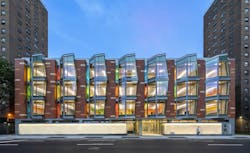Cooke School & Institute Meets Needs of Students Through Appropriate Architecture and Design
All students deserve the right to gain an education in high-quality facilities that prepare them for success. But unlike many independent schoolkids who experience top-notch facilities, special needs students typically get hand-me-downs.
At Cooke School & Institute in East Harlem, New York, however, things are changing. Students have a striking and premier, purpose-built school that consolidates four locations scattered around the city into a central learning hub that is equal to or surpasses some of the state's finest institutions for young people.
Serving students in grades K-12, as well as young adults aged 18-21, Cooke School & Institute is committed to creating a world in which all people with special needs are included as valued members of their communities. Its fresh facility, designed by PBDW Architects, now provides a dignified place of learning for its unique student population. The school offers academic programming, therapy, support and life skills services to children with special needs.
“Historically, students with extreme special needs have not been well served by public schools,” said Ray Dovell, AIA, consulting partner at PBDW Architects. “This has prompted parents to seek alternatives, including the Cooke School. Equity and integration are fundamental to the school’s reason for being, addressing a void in the public education system by providing meaningful education to this often-marginalized student population and preparing them to lead purposeful and fulfilling lives.”
Creating Equity in Educational Environments
When designing Cooke School, PBDW was faced with several challenges, starting with creating a design that would serve a diverse age range within a single facility. Previously split between three locations across Manhattan, the new Cooke School & Institute, located in East Harlem, combines the grammar and high schools and administrative offices into a single, purpose-built facility.
On top of having to combine two schools within a single building, the architects had to accommodate a deed restriction limiting the building height, plus a limited budget, which led PBDW to look at both space- and cost-efficient solutions to address the client’s complex program requirements. The firm is widely known for its work as stewards of New York City’s architectural heritage and is adept at blending new architecture with historic buildings.
To maximize the client’s budget, PBDW made strategic design decisions that made the most of the resources available. “Because the Cooke School is a non-profit organization, it prioritizes its spending on giving its students a strength-based, inclusionary learning experience,” said Dovell.
[Related: South Carolina Hospital Sets New Precedent for Inclusive, Autism-Friendly Healthcare Design]
To help further this mission, Dovell explained that the facility’s design includes several economic and energy efficiencies. Premium materials and finishes are concentrated in the main lobby and corridors, where they have the greatest impact, while more cost-efficient materials are used in the classrooms and therapy spaces. The layout, materials and millwork of the classrooms was standardized to create an efficiency of cost and construction. Additionally, color was used as an inexpensive tool to individualize and customize each classroom.
“The use of color factors prominently in the school’s design,” said Erica Gaswirth, AIA, LEED AP, senior associate at PBDW Architects. “On the exterior, color playfully articulates each classroom and enlivens the front and back facades. Colored slot windows are integrated into the facade at each classroom. These vary by room and enable the students to identify their classroom from the street below. As sunlight passes through these windows over the course of the day, colored shadows move across the floor, offering teaching opportunities about time and earth science. In the evening, the colorful facade creates a distinct and joyful presence in the neighborhood.”
The class sizes at Cooke School are kept small, with much adult support in each. Typically, there are eight to 12 students, plus two to five teachers, depending on the needs of the students. Classrooms are positioned to take advantage of daylight, and each has its own break-out room within the space, where therapists or teachers can work with individuals or small groups as needed throughout the day.
“The big idea behind this project was to create a dignified place of learning, where the students would feel a sense of ownership and pride. While the academic programming at Cooke is cutting edge, its former facilities were antiquated, and the students’ experiences were often compromised due to physical and environmental constraints,” said Gaswirth.
Now, each school has its own speech therapy and counseling offices, as well as occupational therapy gyms with equipment to help develop fine and gross motor skills. There are two Daily Living Labs where students can learn social and life skills in a home-like setting. One lab is outfitted with teaching kitchens that feature residential appliances. The other is furnished like a studio apartment, allowing students to learn how to make a bed and operate a washer and dryer.
“Design that addresses the wellbeing of the inhabitants is especially critical for children who have physical differences, sensory issues and often allergy sensitivities. In addition to accessibility, consideration was given to differences in gait, depth perception challenges in navigating stairs and creating opportunities for building physical strength,” explained Dovell.
Since many of the students have sensory sensitivities, PBDW also paid special attention to acoustics. Windows are unbalanced glazing units to reduce exterior noise. Partitions dampen sound transference between rooms, and wall and floor finishes reduce reverberation within the rooms. Even the fire alarm is refined to respect this special need—it uses melodic chimes instead of clanging horns.
“By looking at the design problem holistically, focusing not only on programming, but also on building performance, operations and maintenance, constructability, energy efficiency, as well as aesthetics and student experience, ensured optimal outcomes in both function and form,” said Gaswirth.
The Cooke School & Institute is remarkable in both purpose and design. The project gave PBDW Architects the opportunity to advance not just the pragmatic needs of the students and teachers, but also to contribute to the quality of life beyond the classroom.
As Gaswirth puts it: “By reflecting the client’s greater purpose of social equity and inclusion, the design will endure philosophically as well as physically, becoming a valuable and lasting asset to the larger community.”
Read next: Historic Library Renovation Becomes a Model for Healthy, Sustainable Design and Innovation
About the Author

Adrian Schley
Associate Editor
Adrian Schley was an Associate Editor for i+s, where she covered the commercial interior design industry since 2018. Her work can also be found in BUILDINGS and Meetings Today.
